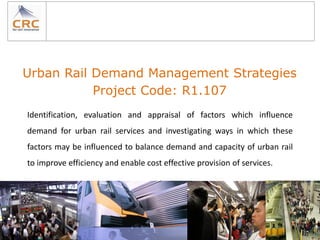
2010 CRC Showcase Urban Rail - Urban Rail Demand Management R1.107
- 1. Urban Rail Demand Management Strategies Project Code: R1.107 Identification, evaluation and appraisal of factors which influence demand for urban rail services and investigating ways in which these factors may be influenced to balance demand and capacity of urban rail to improve efficiency and enable cost effective provision of services.
- 2. 3 Component Projects • Latent Rail Demand – A Perth Case Study • Best Practice Review – City Case Studies • Peak of the Peak Management – Modelling and Estimation 2
- 3. Latent Demand Study Purpose to explore a viable approach to developing a practical decision-support tool for assessing the short-term impacts of the policy and operational adjustments at rail corridor level on the modal changes in the demand for urban rail transit Main Questions: • Where is the likely market for latent demand come from? • How are features of the trips and trip makers? • What is the profile of that market? • What are the major factors impacting the latent demand? • How to simulate the interactions between policy adjustments and demand change? 2 Stage Project • Identification of the potential market population through geographical analysis of the relevant journey to work trip data in ABS Census database; • Estimation of latent demand through behavioural analysis of mode choice modelling by employing local strategic transport model. Methodology • Case Study of the Fremantle – Midland urban rail corridor in Perth 3
- 4. Latent Demand Study Main Lessons Methodology of Adopted Approach is Verified More Accurate Latent Demand Estimation Requires: 1. conduct larger scale and in-depth rail passenger surveys on travel behaviour, such as mode choice, departure time choice, etc; 2. explore and measure unrevealed impact factors on travel mode choice, such as transfer convenience, overcrowding, and personal social-economical characteristics; 3. develop demand estimation models specifically for rail transit station, corridor, or network; 4
- 5. Best Practice Review Purpose to explore established, new and emerging strategic options for coping with peak period demand in major rail networks – and potentially “smoothing” demand through the concerted application of effective management, pricing, planning and other options Project Outline: • Initial identification, evaluation and appraisal of factors which influence demand for urban rail services • Subsequent investigation of ways in which these factors can be influenced to balance demand and capacity of urban rail Methodology • Review of Current Literature and Research • Case Studies of Demand Management Practices in Sydney, San Francisco, Munich and Washington DC. • Synthesis and Performance Benchmarking of International Demand Management Performance 5
- 6. Best Practice Review Main Lessons Many passenger rail systems have lacked active management of passenger demand levels for an extended period. Other agencies are performing reasonably well from a “demand balancing” point of view. Rail demand management appears to be re- emerging as an important discipline in which passenger demand levels are actively managed, in order to deliver “smoother” patronage levels across the day and week. 6
- 7. Best Practice Review Main Lessons Potential areas of strategy and action include: better tracking and management of passenger flows; efficient pricing structures including peak surcharges; encouragements to off-peak travel including customer outreach; “responsive and responsible” network planning, service and infrastructure measures on the supply-side. 7
- 8. Peak of the Peak Management Study Purpose To identify and evaluate demand management options for effectively moderating or smoothing peak demand on Australian Urban Rail Networks Project Outline: • Identification and appraisal of instruments for managing urban rail demand • Validation of the efficacy of targeted instruments • Recommendations for Further Investigation and for Policy Methodology • Review of Current Literature and Research – Best practices in a range of industries • Industry Expert Consultation – Identification and validation of policy instruments • “Proof of Concept” Pilot Demand Modeling and Estimation – Development of a “Rooftops” empirical model and application to the Sydney Cronulla – Illawarra line. 8
- 9. Peak Smoothing Instruments Impact social & institutional peak drivers (e.g. office hour flexibility Reducing underlying campaigns/ telecommuting and internet access, etc.) need for service Land use & transit oriented development to shift travel patterns Changing way in which Use other transport mode interfaces and feeder transit needs are met (timetables), incl. role of active transport (walking and cycling) Increase peak-of-peak fares Reduce shoulder peak fares Pricing & Financial Station-specific surcharges (where high congestion) Mechanisms Employer incentives and disincentives Station parking pricing and/ or availability Fast/express vs. “all stops” services Improve service Service frequency delivery levels during shoulder periods Passenger flow enhancement mechanisms on rail platforms Standing vs. sitting carriages Educating Customers Use transparency in peak fares & crowding levels to shift demand Other Rationing, Queuing 9
- 10. Lessons Learnt – Case Studies Reviewed Sydney Melbourne London SmartSaver Early Bird There is potential for peak smoothing Significant fare differentiation is required Target the critical peak period Service differentiation is key Don’t make it difficult and inconvenient Allow enough time for changes to take effect
- 11. Proof of Concept Study focus Reducing underlying need for service Changing way in which needs are met Pricing & Financial Increase peak-of-peak fares Mechanisms Reduce shoulder peak fares Improve service delivery levels during Fast/express vs. “all stops” services shoulder periods Service frequency Educating Customers Use transparency in peak fares & crowding levels to shift demand Other DRAFT, CONFIDENTIAL 11
- 12. Questions? THANK YOU 12
